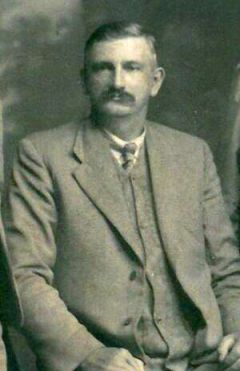View entry
Name: SIMPSON, Hugh

Birth Date: 1886 Killycoogan, Co. Antrim, N. Ireland
Death Date: 9.12.1943 Nakuru
First Date: 1916
Last Date: 1943
Profession: 1916 Scott Laboratory/flax. Farmer
Area: Njoro, 1925 Rongai, Milton's Siding, Subukia
Married: In Ahoghill, Antrim 1920 Anna Mary Close b. 1888 Cullybecky, Co. Antrim, d. 1978 Lanet
Children: Eileen Elizabeth (Sloan) (1923); George Wilson (1924); Sarah (Ingram)
Book Reference: EAWL, Red 31, Hut, Childhood, Barnes, Red 19, KAD, Red 25, Hut
General Information:
Source: Mrs S. Ingram - He joined the Scott Laboratory in Nairobi during the 1st World War. Recruited by the Crown Agents to promote flax growing in Kenya as it was needed for the war (long before the advent of sisal and nylon). He was born in County Antrim, Northern Ireland, to a farming and flax growing family who had their own skutching Mill at Killycoogan.
He travelled to Kenya on the same boat as John L. Riddock. After the war he returned to Ireland and married Anna Mary Close of Cullybecky, County Antrim. On their return to Kenya they first farmed at Bahati. If Anna wanted to see her nearest neighbours, the Miltons of Milton's Siding, she rode the 16 miles on an old mule. Money from the Bank was brought from Nakuru, a round trip of 3 days and 2 nights by an African who wore a blanket, carried no weapons and never a cent was missing.
Following a brief partnership with W.J. Dawson, the Simpsons moved to Rongai to a farm which was mainly swamp. It was good for flax but soon the need for it passed. With very good husbandry, patience, and the necessary draining the land became arable. Maize was the main crop and primary source of income at 2 shillings a bag. They went into cross-breeding native cattle with short horn. Farming was fraught with hazards; East Coast fever was always around, sometimes rinderpest which wiped out whole flocks of livestock, and even the awful anthrax. Animals dying from anthrax were put in deep "lime" filled pits. In this way the disease could be prevented from entering the soil. Then there were the frequent locust visitations. Swarms could devastate whole crops in a night. At dusk as they were about to settle small children were given a 'sufuria' and a spoon and told to beat like mad, along with every other mobile individual, in the hopes that the noise would send the swarms further afield. It never did and by morning there was scorched earth and another year to wait for another crop.
The years between the wars were hard for most farmers. The importation of tractors and harvesters made the growing of wheat on a grand scale possible. Gradually the spans of oxen and the old mules were to be seen no more. It was with great tenacity those years were weathered. Always interested in horticulture, Hugh was the first to produce with great patience and perseverance, a strain of rust resistant wheat. He died in 1943. Anna survived him and latterly moved with their son to Lanet where she died in 1978. After Independence the farm was bought by Jomo Kenyatta
Gazette 18/4/1917 - Arrived on 1st Appointment - Foreman, Plant Instructor - 2/4/1917
Barnes - Nakuru North Cemetery - Anna Mary Simpson, 1888-1978
Barnes - Nakuru North Cemetery - Hugh Simpson, died 9/12/1943
Red Book 1919 - Agricultural Dept. - Flax Instructor - H. Simpson
Red 31 has Hugh L. Simpson, Rongai
